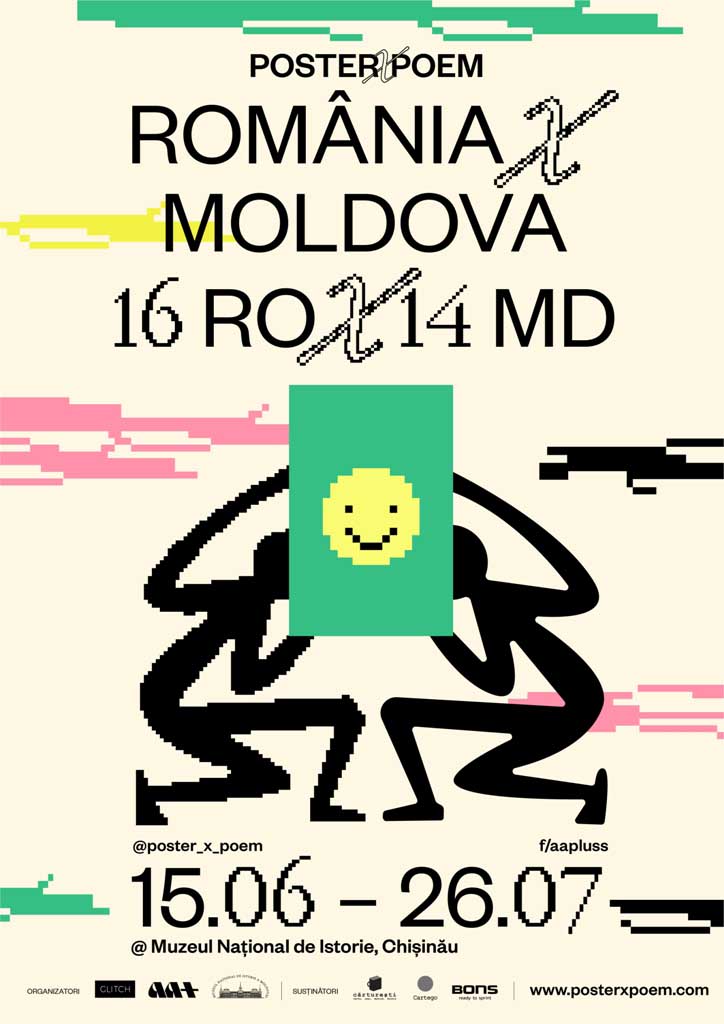The POSTER X POEM exhibition in Chisinau is the first international exhibition within the framework of the POSTER X POEM project, which displays 30 posters inspired by contemporary poetry. The exhibition includes both the posters from the first POSTER X POEM exhibition held in Bucharest and works by Bessarabian artists and can be seen from June 15, on 31 August 1989 Street, no.121 A, on the fence of the National Museum of History of Moldova.
Started in Bucharest in March 2020, POSTER x POEM is an interdisciplinary project that brings together contemporary poets and artists. POSTER x POEM arrived in Chişinău on the initiative of AA +, which invited 14 contemporary poets and 14 artists from Bessarabia to participate.
The posters show poetic texts and their visual interpretation, their authors are the following creative duets: Alexander Vakulovski x Aliona Ciobanu, Moni Stănilă x Veronica Gorii, Paula Erizanu x Maks Graur, Veronica Ştefăneţ x Cristina Halp, Dan Negară x Anna Vasina, Hose Pablo x Sandul, Artur Cojocaru x Alex Escu, Anastasia Palii x Adrian Gavriliuc, Artiom Oleacu x Ecaterina Şălaru, Iulia Iaroslavski x Mihaela Mândru, Ion Buzu x Veronica Belous, Cristina Dicusar x Ana Grigorovscaia, Victor Tzvetov x Cristian Menumortu, Alexandru Cosmescu x Denis Foca.
The POSTER x POEM project was enthusiastically taken by Bessarabian poets. "I was very happy to participate in this project. I think that the interactions between artists of different genres of art are always welcome because they inspire new visions and perceptions", poet Veronica Ştefăneţ mentioned. Based on the concept of "carte blanche", each artist was offered a poem by a contemporary poet as a theme for creating a poster. The only requirement for the work was that the poem and name of the poet were on the poster. "I always thought that poets should be friends with artists, because it depends on them how poetry collections will look like. The next step is posters. Of course, I am glad that a poster will be created by a poem of mine. I can't wait to see it! I saw how a meeting of two artists created a spark. And it's even more beautiful that poetry begins from the street, and returns back to the street. Enjoy it!", poet Alexander Vakulovsky added.
POSTER x POEM started with a first online and offline exhibition on the fence of the National Art Museum of Romania in Bucharest. The first 16 posters of the project were presented in this exhibition, among the invited poets being Tara Skurtu, Dan Coman, Vasile Leac, Andrei Dosa, Mina Decu, Răzvan Ţupa, Teona Galgoţiu and Svetlana Cârstean.
POSTER X POEM believes that poetry must reach as many people as possible and for that it must come out of books and appear on walls and fences. The poster is the perfect medium to take poetry to the middle of the city, among people.
The project is initiated by GLITCH, a communication studio for cultural projects in Bucharest and arrived in Chisinau in collaboration with AA +, a non-formal initiative from Moldova, which focuses its activity around local and foreign visual culture.
 31 August 1989 St., 121 A, MD 2012, Chisinau, Republic of Moldova
31 August 1989 St., 121 A, MD 2012, Chisinau, Republic of Moldova


















































